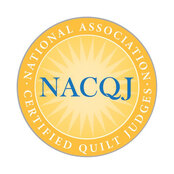|
I just finished a quilt. Always a good feeling, especially if the quilt has been hanging over your head in some kind of obligatory way and you just weren’t into it and you had to make yourself finish it by sheer will power. Yes, there are quilts like that. Being a judge does not mean that every stitch always feels like Cinderella’s little dress-making winged and furry buddies have somehow gotten trapped in your sewing room. Sometimes it’s just drudgery, but eventually you take the last stitch…..probably in the binding.
Ah yes, bindings. What’s the big deal with judges and the binding? Seriously, if I could look back on all the comment sheets I’ve dictated over the past 13 years, probably 95% of them have a binding comment on them and the other 5% would have some other edge finishing remark. We just can’t leave the edges of those quilts alone. It’s such a little thing, compared to all the other components of a quilt; what’s the big deal? That little thing is part of a few much larger concepts in judging. The first is the assumption that the quiltmaker, by entering a quilt for judging, has signaled some level of interest in or curiosity about competition or in improving their quiltmaking. As a judge, I hope that what I say in my comments gives the maker something to work with in making their future quilts more competitive. The magic about a binding comment, though, is that, should the quilter want to, the binding can re-done and that quilt, not some as-yet-unmade quilt in the future, but the one right there, can be made more competitive. It is not uncommon for a quiltmaker with a competitive streak to enter the same quilt in multiple shows, so that quilt will have another shot at a ribbon. And although how a quilt finishes in a show has a lot to do with what other quilts it is competing against on any given day, any weak point that is strengthened can put it in a better position in the next show. And now a side comment: I think many quilters enter their quilts in their home guild’s quilt show and that’s that. It’s a one shot deal. Let me suggest to you that you consider entering the same quilt into multiple shows, assuming that other shows are available within a reasonable distance and the expense is not prohibitive. More feedback, more experience, is always good and can either, through multiple mentions, point at things to improve or let you know you really are doing well. Back to binding and the second larger judging concept. Many judging points are based on longevity for the quilt. I’ve said it before, but I want your quilt to be around a long, long time. Typically, the place where a quilt wears the most is on the binding. A well-executed binding is your quilt’s first line of defense, so it’s worth keeping in mind some of the binding judging points:
And a final judging concept: the entrant is given credit for demonstrating attention to detail and mastery of the art of quiltmaking. Some binding judging points are not so clearly about longevity, they’re about quilting flash.
So yes, a binding is little, but it does a big job. And it’s just one kind of edge finish. Stacy Koehler, Secretary, NACQJ NQA Certified Judge Qualified to Evaluate Masterpiece Quilts
3 Comments
Allison Rainboth
7/25/2018 12:14:07 pm
Thanks for this well-worded discussion about edges. I've had entrants tell me that almost every quilt gets some sort of comment about edge treatment. It's always fun to tell them that if the judge made a positive comment - Binding well executed, whatever - that is a big deal!
Reply
Charlotte Powell
7/29/2021 05:23:43 pm
Thank you for this information. Stitches on the binding are to be small and hidden…,what is small? 5 stitches per inch? 8 stitches per inch? I cannot find this information anywhere and want to do it right! Thank you!
Reply
7/29/2021 06:10:27 pm
I space the distance between stitches based on the future use of the quilt. Heavy use or show quilt, a stitch every 1/8 inch, less heavy use, 1/4 apart. Hope this helps.
Reply
Leave a Reply. |
AuthorStacy Koehler became an NQA Certified Judge in 2005. She is a current member of the National Association of Certified Quilt Judges and has served as the new organization's Secretary. She loves quilts and quilters and believes that a well-judged quilt can be a positive influence in its maker's individual development and contribute to the continued growth of the art of quiltmaking. Archives
July 2018
Categories |



 RSS Feed
RSS Feed